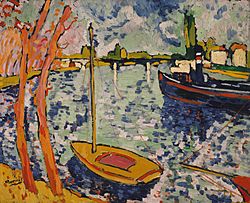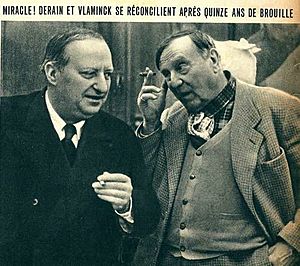Maurice de Vlaminck facts for kids
Quick facts for kids
Maurice de Vlaminck
|
|
|---|---|

Maurice de Vlaminck. The River Seine at Chatou, 1906, Metropolitan Museum of Art
|
|
| Born | 4 April 1876 Paris, France
|
| Died | 11 October 1958 (aged 82) Rueil-la-Gadelière, France
|
| Known for | Painting |
Maurice de Vlaminck (born April 4, 1876 – died October 11, 1958) was a French painter. He is known as one of the main artists in the Fauve movement. This group of modern artists used very bright and strong colors in their paintings. They were active from 1904 to 1908. Vlaminck was one of the Fauves who showed their art at the famous Salon d'Automne exhibition in 1905.
Contents
Life of Maurice de Vlaminck

Maurice de Vlaminck was born in Paris, France. His father was a musician who taught violin. His mother taught piano. Maurice learned to play the violin from his father. He started painting when he was a teenager.
In 1893, he studied art with a painter named Henri Rigalon. A very important moment in his life happened in 1900. While on a train, Vlaminck met another artist named André Derain. They became lifelong friends. After Vlaminck finished his time in the army, they shared a studio together for a year. Vlaminck painted during the day. At night, he gave violin lessons and played music in bands to earn money.
Vlaminck showed his paintings at the 1905 Salon d'Automne exhibition. When an art critic saw the bold, colorful paintings by Vlaminck, Henri Matisse, André Derain, and others, he called them "fauves." This French word means "wild beasts." This is how the art movement got its name, Fauvism.
In 1911, Vlaminck visited London and painted near the River Thames. In 1913, he painted again with Derain in France. During World War I, he was in Paris and started writing poetry. Later, he moved to a small village called Rueil-la-Gadelière. He married his second wife, Berthe Combes, and they had two daughters. From 1925, he traveled around France. However, he mostly painted along the Seine River near Paris.
Vlaminck was not happy that Cubism became more popular than Fauvism. He felt that Pablo Picasso had made French painting confusing. During World War II, Vlaminck visited Germany. When he came back, he wrote an article criticizing Picasso and Cubism. Maurice de Vlaminck also wrote many books about his own life. He died in Rueil-la-Gadelière on October 11, 1958.
Vlaminck's Art Style
Two of Vlaminck's early important paintings, Sur le zinc (At the Bar) and L'homme a la pipe (Man Smoking a Pipe), were painted in 1900. For several years, Vlaminck lived near Chatou. He painted and showed his art alongside Derain, Matisse, and other Fauvist painters.
During this time, his paintings showed the influence of Vincent van Gogh. He used lots of paint and bright, lively colors. In his landscape paintings, he didn't focus on small details. Instead, he used strong colors and brushstrokes to show feelings and moods. An example is his painting Sous bois from 1904.
The next year, he started to "deconstruct" things. This means he turned the real world into dabs and streaks of color. This made his paintings feel like they were moving. Paintings like Le Pont de Chatou (The Chatou Bridge) and La Seine a Chatou (The River Seine at Chatou) show this style.
Artistic Influences
Vlaminck's paintings show that he knew about the Impressionists. These artists had painted in the same areas in the 1870s and 1880s. After seeing an exhibit of Van Gogh's work, Vlaminck said he loved Van Gogh's art very much.
After 1908, Vlaminck started using fewer colors. The main influence on his art became Paul Cézanne. His later paintings used darker colors. He often added strong strokes of white paint to create contrast. Some of his artworks are kept at the Minneapolis Institute of Art.
Images for kids
See also
 In Spanish: Maurice de Vlaminck para niños
In Spanish: Maurice de Vlaminck para niños






